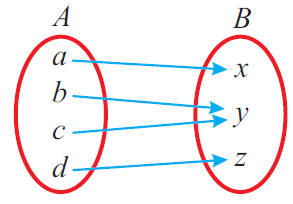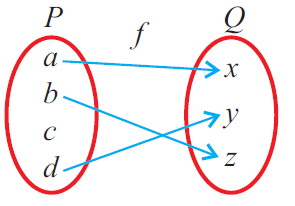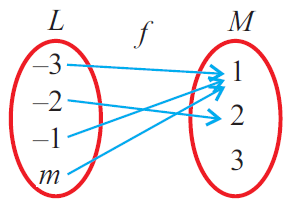HOW TO DETERMINE WHETHER THE RELATION IS A FUNCTION
Subscribe to our ▶️ YouTube channel 🔴 for the latest videos, updates, and tips.
Let f be the rule which maps elements from the set A to set B.
That is,
f : A ---> B
If a relation is a function, it has to satisfy the following conditions.
(i) Domain of f is A.
(ii) For each x ∈ A, there is only one y ∈ B such that
(x, y) ∈ f
Let us look at some examples to understand how to determine whether a relation is a function or not.
Example 1 :
Does the following relation represent a function ? Explain.

Solution :
Let f be the rule which maps elements from the set A to set B.
Then,
Domain of f = {a, b, c, d} = A
And also, for each x ∈ A, there is only one y ∈ B.
So, the above relation is a function.
Example 2 :
Does the following relation represent a function? Explain.

Solution :
Let f be the rule which maps elements from the set C to set D.
Then,
Domain of f = {2, 4, 3} = C
For the element '2' in set C, there two images '20' and '40' in D.
So, the above relation is not a function.
Example 3 :
Let X = {1, 2, 3, 4}. Examine whether the relation given below is a function from X to X. Explain
f = {(2, 3), (1, 4), (2, 1), (3, 2), (4, 4)}
Solution :
Domain of f = {1, 2, 3, 4} = X.
For the element '2' in set X, there two images '3' and '1' in Y.
So, the above relation is not a function.
Example 4 :
Let A = {1, 4, 9, 16} and B = {–1, 2, –3, –4, 5, 6}. Examine whether the relation given below is a function from A to B. In case of a function, write down its range.
f = {(1, –1), (4, 2), (9, –3), (16, –4)}
Solution :
Domain of f = {1, 4, 9, 16} = A.
Each element in A has a unique image in B.
That is, no element of A has two or more different images in B.
So, the above relation is a function.
Range of f = {-1, 2, -3, -4}.
Example 5 :
Let X = {1, 2, 3, 4, 5}, Y = {1, 3, 5, 7, 9}. Examine whether the relation given below is a function from X to Y. In case of a function, write down its range.
If determine which of the following relations from X to Y are functions? Give reason for your answer. In case of a function, write down its domain, co-domain and range.
R = {(1, 1), (2, 1), (3, 3), (4, 3), (5, 5)}
Solution :
Domain of R = {1, 2, 3, 4, 5} = X
Each element in A has a unique image in B.
That is, no element of A has two or more different images in B.
So, the above relation is a function.
And also,
Domain = {1, 2, 3, 4, 5}
Range = {1, 3, 5}
Co domain = { 1, 3, 5, 7, 9 }
Example 6 :
Is the relation 'f' in the diagram shown below a function ? Explain.

Solution :
From the above arrow diagram,
Domain of f = {a, b, d} ≠ P.
So, the relation 'f' is not a function.
Example 7 :
Is the relation 'f' in the diagram shown below a function ? Explain.

Solution :
From the above arrow diagram,
Domain of f = {-3, -2, -1, m} = L
Each element in L has a unique image in M.
That is, no element of L has two or more different images in M.
So, the relation 'f' is a function.
Subscribe to our ▶️ YouTube channel 🔴 for the latest videos, updates, and tips.
Kindly mail your feedback to v4formath@gmail.com
We always appreciate your feedback.
About Us | Contact Us | Privacy Policy
©All rights reserved. onlinemath4all.com

Recent Articles
-
10 Hard SAT Math Questions (Part - 45)
Jan 19, 26 06:14 AM
10 Hard SAT Math Questions (Part - 45) -
10 Hard SAT Math Questions (Part - 44)
Jan 12, 26 06:35 AM
10 Hard SAT Math Questions (Part - 44) -
US Common Core K-12 Curricum Algebra Solving Simple Equations
Jan 07, 26 01:53 PM
US Common Core K-12 Curricum Algebra Solving Simple Equations
